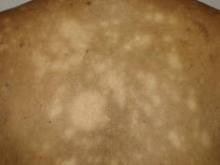Hypopigmentation is a result of inflammatory conditions or trauma in patients with darker skin. While there are many treatments for hyperpigmentation, there are fewer options for hypo.
Some of the clearly defined options that exist for hypopigmentation include using anti-inflammatories for conditions such as vitiligo and pityriasis alba (topical corticosteroids, tacrolimus, or pimecrolimus).
For hypopigmentation from tinea versicolor, repigmentation after treatment with antifungals does occur although it can be delayed for months. But for postinflammatory hypopigmentation or hypopigmented scars, what can be done?
Pharmaceutical treatments
Puvasol, topical psoralen, and ultraviolet light (natural sunlight or UVA phototherapy), may help speed the repigmentation of hypopigmented patches, particularly in cases caused by laser therapy.
In patients with postinflammatory hypopigmentation following laser hair removal, the repigmentation may also recur on its own if the initial insult from the laser was superficial, although repigmentation can take months. Topical psoralen can be applied to affected areas, and should be done 20-30 minutes before the patient sits in direct sunlight (for just a few minutes). Caution must be taken to avoid blistering and sunburn.
V-Tar, a 30% standardized, water-soluble, coal tar topical, has been used successfully in many patients with vitiligo and other hypopigmentary disorders. It is available by prescription, and is applied once daily (Skin & Allergy News, March 2002, pg. 39).
Laser Treatments
The 308-nm excimer laser has been studied as an effective treatment for localized hypopigmented scars and striae alba. In one study, minimal erythema dose tests were performed for 31 patients at 100, 150, 200, 250, 300, and 350 mJ/cm2. Each patient was then treated with his or her minimal erythema dose minus 50 mJ/cm2. Subsequent treatments were performed biweekly until 50%-75% pigment correction was achieved, and every 2 weeks thereafter for a maximum of 10 treatments, a 75% increase in colorimetric measurements, or 100% visual pigment correction. However, maintenance treatment every 1-4 months was required to sustain cosmetic benefit (Arch. Dermatol. 2004;140:955-60).
In another study, a 1550-nm Fraxel laser was used to treat seven patients with hypopigmented scars on the face. Energy settings ranged from 7 mJ to 20 mJ and a total density of 1,000-2,500 microthermal zones/cm2. Six patients experienced 51%-75% improvement in hypopigmentation after two to four consecutive treatments spaced 4 weeks apart. One patient had a 26%-50% improvement (Dermatol. Surg. 2007;33:289-94).
Fractionated resurfacing is also helpful in evening out skin tone when there is a mixture of hypo- and hyperpigmentation from chronic UV exposure or poikiloderma. In addition, cultured epithelial autografts have been used to treat hypopigmentation secondary to burns.
Dyspigmentation is a common concern among patients with skin of color. Hypopigmentation caused by disease or scarring can be ameliorated by treatments using psoralens, tar, and lasers; however, more data and additional treatment options are needed to address the common and often difficult-to-treat dyschromia we see in this patient population.


